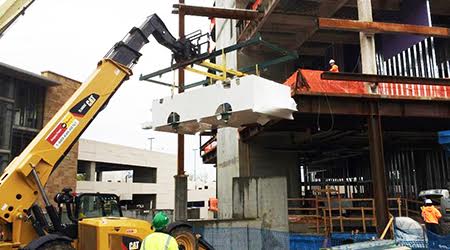Considerations for Using Prefabrication in Healthcare Construction
Prefabrication can save time and money, but keep these strategies in mind to ensure a successful project.
By Jose Torres and Kirstie Nugent
COVID-19 has created a litany of challenges for many industries, especially construction. Challenges with social distancing and worksite safety, coupled with ever-present workforce shortages, delays, and cost increases, have contractors and developers looking for efficient and affordable options. The result is a robust interest in prefabrication, or off-site building. The traditional advantages are well known: increased quality control, faster completion, and lower costs, but by its very nature, prefabrication also lends itself perfectly to today’s pandemic environment. Off-site building requires fewer workers in close proximity, which makes the enforcement of social distancing easier.
In this article, we will outline design considerations that should be taken into account to ensure a successful prefabrication project, utilizing two prominent applications MEP rack and bathroom pod projects as examples.
One of the most important factors in the prefabrication process is timing. The decision to use prefabrication should be made early in the project timeline to achieve maximum efficiency and cost-saving benefits. Additionally, the nature of the design must be taken into consideration. Projects with a repetitive architectural layout are better suited to use pre-fabrication for the MEP systems layout.
Designing for MEP racks involves allocating space for each of the trades that will be included in them, and any other outside systems that will be sharing the same ceiling space. Corridor width can play a big part in the success of these racks as well. While some utilities can be stacked and need little accessibility, there are other items that will need to be easily accessed through ceiling tiles or access doors. One option that can be used in some cases to remedy this issue is specifying bottom access VAV boxes. The rack itself will take at least four inches away from the usable width of the corridor, and another four inches from the height. This number can increase, however, if the racks require additional support for VAV boxes, duct, and piping mains. Additional considerations should be made for projects with seismic requirements. For example, in a recent project, seismic bracing was required for the fire protection system but not for the other MEP systems. As such, the sprinkler piping was left out of the racks. If it had been included, then the entire rack would have required seismic bracing.
Designing for bathroom pods in pre-fabrication requires architectural and MEP system consistency as well. Wall layouts, ceiling layouts, fixtures, and systems should be the same for each room. The prefabricated pods include all items inside the bathroom, as well as within the walls and directly above the ceiling. For healthcare settings, pre-fabrication is most advantageous in inpatient units with repetitive patient rooms with their own bathrooms.
Because all materials are built at a factory and not on site, the design team must also consider how the racks and pods will be transported once built. This can place limitations on rack size. For the MEP racks, the maximum length has been placed at 20 feet long, based on pipe run length. At these 20-foot segments, four racks are able to be placed on each truck. The construction team must take into consideration how to bring these large items into the building. Once transported inside, the racks are mounted in the ceiling with duct jacks and the connections from one rack to another are made. The same concepts apply when working with bathroom pods.

After the design stage is complete and construction begins, the pre-fabricated items are the first to be built. Shop drawings are submitted with all disciplines under the same submittal for both the MEP racks and the bathroom pods. The submittal typically includes the BIM coordination and provides the design team with a 3D model to review in addition to the drawings. These reviews should also include meetings with the maintenance team, who will need to know the items requiring access and how much space they will have to work in. Because prefabrication is a repetitive process, this crucial step ensures that all items are coordinated together for the review. Once construction begins on these items, any changes can be extremely challenging, if not impossible, to implement because of the cascading effect on other disciplines and the entire pre-fabrication process.
Each prefabrication project is constructed in a designated space in the factory to allow all trades to work together to create the necessary project items. This could include labor skilled in mechanical, electrical, plumbing, medical gas, etc., depending on what is required for the project. A tagging system is put into place to ensure proper transport and placement once the items reach the site.
As with all projects, testing and inspection is crucial. For prefabrication, this begins at the factory. Pressure testing of all piping is completed at the factory for both the MEP racks and the bathroom pods. Once all parts are connected, whole system testing, and flushing is completed in the field. The authority having jurisdiction will make inspections in the field, so it is important that the design and construction teams understand ahead of time what issues might arise and try to mitigate them in advance.
Although prefabrication accelerates the construction timeline, it requires modifications to the typical completion of the exterior – placing 20-foot long racks into a building in one piece is not typical in the field. The construction team should bring in the MEP racks with a crane through larger holes in the building exterior before the entirety of the exterior is completed. Bathroom pods require the same rigging. Furthermore, they must be placed before wall framing is complete in the adjacent spaces since they cannot fit through a typical doorway.
Lastly, while prefabrication saves money in the short term during the construction process, the owner must consider the long-term implications of utilizing pre-fabricated items in the building. For example, MEP racks could potentially make renovations more difficult in the long run. Access for annual maintenance and eventual replacement should be taken into consideration during the construction process, since the pre-fabricated racks take up a significant amount of ceiling space.
While pre-fabrication can provide significant benefits to the owner, everyone involved in the project must understand its unique challenges to maximize the return. By understanding these challenges, the team can proactively provide solutions that will result in a better-quality end product in a shorter time span.
Jose Torres is a Partner at RMF Engineering’s Raleigh, N.C. office. He leads the team’s buildings focused practice, which includes nearly 30 professionals serving primarily healthcare facilities throughout the southeast.
Kirstie Nugent is a mechanical engineer at RMF Engineering’s Raleigh, N.C. office, with experience in designing HVAC, plumbing, fire protection, and medical-gas systems. Her project experience includes multi-story hospitals and bed tower additions, medical office buildings, ambulatory surgical centers, and complex renovations.
Related Topics:











